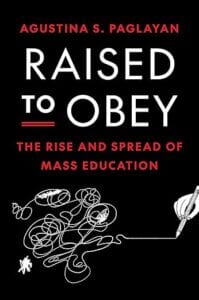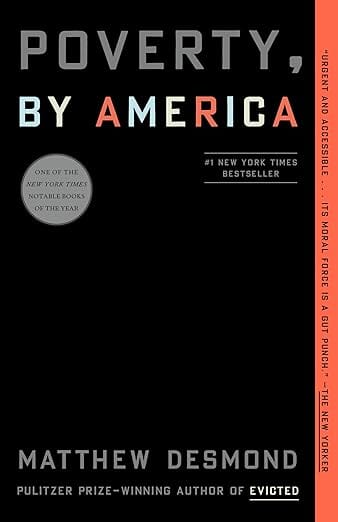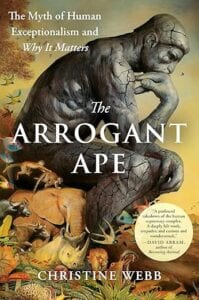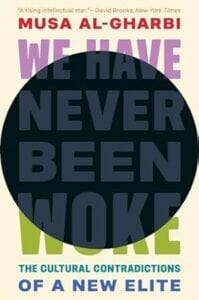Book Review of Poverty, By America, by Matthew Desmond.1
I had not planned to read this book. I found the author’s essay on the history of American capitalism for the New York Times Magazine‘s 1619 Project badly wanting, so I passed over Poverty, By America, until one of my students (a sociology major) asked me about it because he was reading it for his Sociology of Poverty course. Matthew Desmond is a passionate writer, but verve and fervor are poor substitutes for sound arguments backed by carefully interpreted data. Desmond’s conviction and moral certitude are clear on every page—a reviewer for The New Yorker writes, “Its moral force is a gut punch”—but his argument is ultimately unconvincing.
He comes out swinging, beginning his prologue for Poverty, By America with “Why is there so much poverty in America? I wrote this book because I needed an answer to that question.” The word “By” in his title suggests that poverty isn’t just something in America. It’s in America because of America. But as John F. Early explained in his review for the Cato Institute’s Regulation,2 Desmond is never clear on what he means by “so much,” particularly given that the Organization for Economic Cooperation and Development’s reported poverty line changes by country. Its “poverty rate” is the fraction of the country’s population at or below half that country’s median income, which means comparing countries’ poverty rates using the OECD’s headline measure compares apples to oranges. If we measure every country by the same standard, either the U.S. Federal Poverty Line or half of the U.S. median income, the United States goes from having one of the highest poverty rates in the OECD to having one of the lowest. I doubt, however, that a book titled Poverty, By Scandinavia would have been one of the New York Times’ Notable Books of the Year.
Nonetheless, I found myself nodding my head in agreement regularly. Desmond rightly draws attention to where we have earned blame. We pay far too little attention to policies and programs that redistribute income and wealth upward. We don’t think of economically and morally suspect tax breaks and credits (like the mortgage interest deduction) as government benefits, even though there might not be an economic difference between a tax break and a subsidy, despite the linguistic difference. And so, he points to a way Americans “spend” a lot on welfare for the well-off without it looking like we’re doing so. As scholars have pointed out, Americans run many of our social and redistributive policies through special provisions in the tax code. If, for example, you pay $50,000 in taxes and then get a check from the government for $10,000, you’re out $40,000. If you calculate a $50,000 tax bill and then get a $10,000 tax credit, you’re still out $40,000. The money is the same, but the language is different.
I think we might be able to agree on welfare reform because the system we have right now is pathological in terms of the incentives it creates, and what’s more, it is more upwardly redistributive than we are inclined to think. Replacing the dog’s breakfast of sometimes self-contradictory welfare programs with an expanded Earned Income Tax Credit would win the hearty applause of most economists. Even if we couldn’t do that, there are plenty of places where we can remove clogs and chokepoints in a dysfunctional system. We part ways on the economic incidence of the Earned Income Tax Credit, which Desmond thinks is subsidizing employers and allowing them to pay lower wages. He’s right, to a point, but if this source is correct and the pass-through is at most 36% of each EITC dollar,3 then workers are still getting the lion’s share of the benefit. And besides, it’s a staple of introductory economics classes that the economic incidence of a tax or subsidy depends on the elasticities of the supply and demand curves, so it’s not clear we can subsidize work without at least some of it going into employers’ pockets.
That brings us to the minimum wage, which Desmond thinks should be raised but is at best a very poorly targeted antipoverty program. In a 2015 paper, Thomas MaCurdy shows how higher minimum wages are, if anything, regressive insofar as they transfer income from low-income consumers to low-income workers.4 Desmond repeats the old trope that economists believed the minimum wage caused unemployment because the theory said so before David Card and Alan Krueger blew up the profession by looking at the data. However, empirical studies of minimum wage predate Card and Krueger by decades. Desmond seems to believe the minimum wage is a free lunch, at least for workers. While he cites work by David Neumark and William Wascher, he doesn’t give the criticisms of the minimum wage their due. I don’t expect him to get into the weeds of debates about identification strategies and the like. However, I’m still confident enough that labor demand curves slope downward. Labor supply curves slope upward, meaning higher minimum wages reduce employment and induce people to waste resources searching harder for jobs that are harder to come by. I don’t lose sleep over teaching this. Economists Jonathan Meer, Jeffrey Clemens, and many others have shown that, for example, higher minimum wages mean fewer non-wage benefits and more effort expended searching for work.
Desmond rightly takes his fellow progressives to task for displaying Black Lives Matter flags and those “In this house, we believe…” signs while also fighting tooth and nail to maintain exclusionary zoning in the name of protecting the “character of the neighborhood.” Having written an earlier book called Evicted about the trials and travails of getting kicked out of an apartment for not paying your bills, it’s no surprise that Desmond finds housing policy so important. He should be able, I hope, to make common cause with libertarians like Bryan Caplan, who are working to identify and reduce the regulatory burden on new housing construction. Unfortunately, he endorses “inclusionary zoning,” which requires new projects to include a set-aside for “affordable housing”—a nebulous term, to say the least–that acts as a tax on any new construction and that requires builders to gravitate toward units that will generate enough revenue to pay for the below-market “affordable” units.
Desmond is also correct about the folly of scapegoating immigrants for all that ails us. Growing empirical research shows that foreigners (whether over here or over there) aren’t taking our jobs. Foreigners over here aren’t bankrupting the welfare state or turning our cities into criminal wastelands. Indeed, the data suggest that even illegal immigrants have lower crime rates than natives. Blaming immigrants is a venerable American (indeed, human) tradition with ugly manifestations during the Progressive Era, where eugenicists and racists thought it necessary to control immigration lest the immigrants pollute the gene pool.
“The familiar scapegoats are well-represented, as is the usual hero: government, but this time, a government that does the Will of the People.”
Unfortunately, however, Desmond blames the usual list of suspects: corporations, speculators. Republicans, Ronald Reagan. The familiar scapegoats are well-represented, as is the usual hero: government, but this time, a government that does the Will of the People.
First, Desmond asks why the richest country in the world has “so much poverty.” It’s a fair question, but it’s unclear exactly what would no longer be “so much poverty.” He doesn’t contextualize some of his numbers and slips back and forth between incommensurate definitions when he wants to make international comparisons. Domestically, he uses the federal poverty line and is aghast that there were some 38 million people in the United States who lived below the federal poverty line as of 2021. It’s a “country” larger than Venezuela and Australia (and, I would add, richer than Venezuela). Any decent person, I suspect, would say that’s 38 million too many, but it’s about 11% of the population–and over the long run, it’s headed in the right direction.
Crucially, the story you can tell depends on which endpoints you pick. In Desmond’s book, Ronald Reagan gets a lot of blame, but what is Reagan’s record on poverty? When Reagan took office in 1981, 14% of the population lived in poverty. It had fallen to 12.8% by the time he left in 1989. Should Reagan get credit for this? It increased to 15.1% in 1993 (when Bill Clinton took office) before falling to 11.7% in 2001, when Clinton left office. It was 14.3% when George W. Bush left office in 2009 and then went back down to 12.3% after Obama left in 2017. By the end of Donald Trump’s first term, it was 11.6%. The fraction of the population in poverty has remained stubbornly stuck in the 11-15% range since the late 1960s. Desmond is eager to credit the Great Society with falling poverty; these lower poverty rates reflect the continuation of trends that started earlier. As Early explains, “Had poverty merely maintained its pre-1964 trend, it would have been 9.2 percent in 1974, not 11.2 percent.”
Desmond reports many facts, but as Steven Landsburg has explained, nothing is less interesting than a fact unilluminated by a theory. And Desmond’s theory doesn’t go beyond “employers/corporations/landlords/Republicans are mean.” Maybe so. Mr. Potter in It’s A Wonderful Life and pre-conversion Ebenezer Scrooge in A Christmas Carol had rotten souls. But at the risk of sounding condescending, incentives matter much more than intentions, and too often, Desmond makes claims that, if true, imply that the profit-obsessed sociopaths he excoriates are systematically overlooking opportunities to make gobs of money by hiring armies of “underpaid” workers. It’s Schrodinger’s Corporation: simultaneously blinded by the profit motive and blind to the enormous profits they could enjoy by offering better pay and benefits to other firms’ “underpaid” workers and pocketing the still-enormous difference between this slightly higher pay and what the workers produce.
We can say something similar about Desmond’s poverty victims suffering “exploitation,” a word he uses loosely. Desmond claims that housing is more expensive in low-income neighborhoods than in higher-income neighborhoods, which means landlords are exploiting the poor. But why don’t the poor who are overpaying for housing in the bad part of town lower their housing costs by moving to the nice part? Desmond’s explanations for why they don’t, which include poor credit histories and episodes of non-payment that mean they get turned down for apartments in the nice parts of town, suggest that what he has identified is a risk premium and not “exploitation.” As he explains, landlords take home profits for many years because bad things don’t happen every year, but all it takes is one large enough riot or natural disaster to turn years of profits into a single year of catastrophic losses.
Desmond illustrates his argument with tragic and frustrating anecdotes that raise obvious but unanswered questions his “exploitation” argument can’t answer satisfactorily. He tells the story of Julio (not his real name, obviously), who worked two full-time jobs to support his family and collapsed from exhaustion in a grocery store. Later, he doesn’t have to work as hard due to the higher minimum wage in Julio’s California town. Good for Julio. What we don’t see, however, is the people who can’t supply the hours they want to supply (or get a job at all) because they aren’t productive enough to be employable at the minimum wage.
Furthermore, Desmond explains that Julio wouldn’t have the problem of low wages and a porous social safety net if he lived in Denmark. So why doesn’t Julio move his family to Denmark, where he would have higher wages and greater security? The answer is that Denmark wouldn’t have him. Denmark is a lovely place where I’ve spent more time than I’ve spent in any other country save the United States, but it’s also a difficult place to move to legally. The Scandinavian welfare states “work” in part by keeping non-Scandinavians out and maintaining a homogeneous culture of “we’re all Danes (or Swedes, or Norwegians), and we don’t cheat our fellow Danes (or Swedes, or Norwegians).” The Danes are lovely people, Denmark is lovely, and I wear my FC København jersey proudly. However, if the entire world were a large American city, the Scandinavian countries would be the exclusive, highly regulated suburbs with rules written to keep the riffraff out.
Some of Desmond’s anecdotes seem calculated for minimum sympathy. There’s the story of a father snorting speedballs at work that doesn’t lead to the obvious conclusion, “don’t snort speedballs at work.” He tells the tragic story of Crystal, who bounced around in the foster care system. It’s a tragic origin story, of course, but it seems like it was at least possible for her to have avoided homelessness and prostitution. She quit high school at 16. She “met a woman at a homeless shelter and secured another apartment with her new friend” (page 12). Great! But then we read the next sentence: “Then Crystal put that new friend’s friend through a window, and the landlord told Crystal to leave” (page 13).
So, Crystal lost her apartment for throwing her roommate’s friend through a window. Unless it was a first-floor apartment, this seems like a pretty credible case for an attempted murder charge, not just eviction. Are we to be surprised that this isn’t the sort of tenant a landlord wants? But fortunately, Crystal had a network to fall back on as she “spent nights in shelters, with friends, and with members of her church” (page 13). Great! But a bit later, we learn that she “burned through the remaining ties she had from church and her foster families” (page 13). How, exactly? Poverty, By America is a short book for a general audience, but these seem like obvious questions a general audience would want answered. Desmond at least concedes (perhaps inadvertently) that Crystal isn’t wholly bereft of agency, noting that “Crystal had never been an early riser, but she learned that mornings were the best time to turn tricks, catching men on their way to work” (page 13). That raises another question about the economics and sociology of poverty: how many of her clients would suffer less if they weren’t in the habit of paying for sex en route to work?
Desmond criticizes the “success sequence,” touted by conservative think tanks and which says that your probability of living in poverty is very low if you simply finish high school, work full time (at any job, not just a “good job,” as Desmond suggests), and don’t have children out of wedlock. Desmond says, “we might as well be asking that person to just get a different life” (page 40), but presumably, we study poverty and make policy to alleviate it because poor people want different lives. It’s not clear what to do about people like Crystal, who have, it seems, exacerbated poor choices by burning bridges, but it seems like a can’t-miss message for young people who still have time to make “success sequence” choices. And one has to wonder: would Crystal herself advise teenage girls to drop out of school at 16, get evicted for throwing someone through a window, and burn through the remaining ties they might have from church, family, and other relationships, no matter how tenuous? Would she look back and say, “This was inevitable? There is literally nothing I could have done to avoid this?” I doubt it.
But here, Desmond’s message to the rock-ribbed and presumably hard-hearted conservative should resonate, at least slightly. If we’re all honest with ourselves, we can all look back at times when something random could have led to very different life outcomes. Think back to when you either made or barely avoided a poor choice. How different would things be had that gone the other way? A sober assessment of our lives should show us that things could be much better, but could also be much worse.
But what do we do with that? I walk our dog in Birmingham’s Avondale Park every morning and most evenings. We live in a checkered-but-gentrifying neighborhood where many buildings are empty thanks to city rules and permitting processes making it hard to do anything with them (which helps explain Desmond’s invocation of Birmingham’s apartment vacancies on page 65). Several homeless people live in the park and on the streets surrounding it, and when I want to get annoyed, I just tell myself, “There but by the grace of God go I.” But what do I do about it? I don’t have a good answer. Service and outreach organizations (government and private sector) that provide health care, job training, food, and other services are within easy reach of Avondale Park. Why aren’t they using these services? I don’t know.
At the beginning of the book, Desmond writes that “some lives are made small so that others may grow” (page 8). He’s correct, up to a point, and for most of history, the way to get rich was to steal, kill, and destroy. High real estate values are a product of exclusionary zoning and rules that make it difficult and costly to build new housing, but that doesn’t mean Jeff Bezos earns a lot because Amazon workers don’t. As Deirdre McCloskey and I argued in our 2020 book Leave Me Alone and I’ll Make You Rich, the best thing we can do for people is to get out of their way. Stop expecting them to ask permission to try new things, innovate, buy low, and sell high.
Desmond wants to outlaw low wages, but while this might mean some people like Julio feel better off, he is silent on the people who will not be able to work if the jobs they can actually do are outlawed. He wants people to boycott companies that offer low wages and lousy working conditions, but would he suggest boycotting U.S. women’s soccer because the U.S. women’s team doesn’t earn what the U.S. men’s team earns? I doubt it. Should we have a more generous welfare state? Once you account for private and government welfare spending, U.S. and Nordic welfare institutions are comparable, and we didn’t get European-style welfare states not because of some sinister conspiracy but because mutual aid societies and industrial sickness funds worked well (Davie Beito’s book From Mutal Aid to the Welfare State and John Murray’s Origins of American Health Insurance make these points clear).
He also wants to strengthen labor cartels, known as unions, but unions increase their incomes by shutting out competitors. Unions are great for insiders and not so great for outsiders. It’s not clear that the distributional consequences are desirable. Desmond is right that we would make things much better by eliminating exclusionary zoning and making it possible to build housing more densely, but he doesn’t devote a lot of attention to licensing laws that severely restrict the flexibility of the labor market. I would have been encouraged to see Desmond draw on economics’ work on housing markets, occupational licensing, and immigration to propose radical economic liberalization, but he doesn’t.
For more on these topics, see
Why Housing Is Artificially Expensive and What Can Be Done About It (with Bryan Caplan). EconTalk.
Thomas Leonard on Race, Eugenics, and Illiberal Reformers. EconTalk.
“Americans Are Still Thriving,” by Jeremy Horpedahl. Library of Economics and Liberty, October 2, 2023.
Poverty, By America is an interesting but ultimately unnecessary and fundamentally flawed book. You can it skip safely if you want to understand poverty and prosperity. To borrow a cliche, what is original in the book is incorrect, and what is correct is not original. Poverty bothers Matthew Desmond to his core; this is commendable. However, anyone who picked up this book and used it as a manual for poverty abolition would be sorely disappointed.
Footnotes
[1] Matthew Desmond, Poverty, By America. Crown, 2024.
[2] John F. Early, “Feeling Poverty But Not Understanding It.” Regulation. Winter, 2023-24. Available online at: https://www.cato.org/sites/cato.org/files/2024-01/regulation-v46n4-in-review.pdf
[3] Natalie Holmes and Adam Berube, “The Earned Income Tax Credit and Community Economic Stability.” Brookings, November 2015. Available online at: https://www.brookings.edu/articles/the-earned-income-tax-credit-and-community-economic-stability/
[4] Thomas MaCurdy, “How Effective is the Minimum Wage at Supporting the Poor?” Journal of Political Economy, Vol. 123, No. 2, April 2015.
*Art Carden is Margaret Gage Bush Distinguished Professor of Economics and Medical Properties Trust Fellow at Samford University in Birmingham, AL and a Research Fellow with numerous organizations.
I thank ChatGPT 4o and o3 as well as Google Gemini and Grammarly Pro for valuable research and editorial assistance.
For more articles by Art Carden, see the Archive.
As an Amazon Associate, Econlib earns from qualifying purchases.
(0 COMMENTS)








